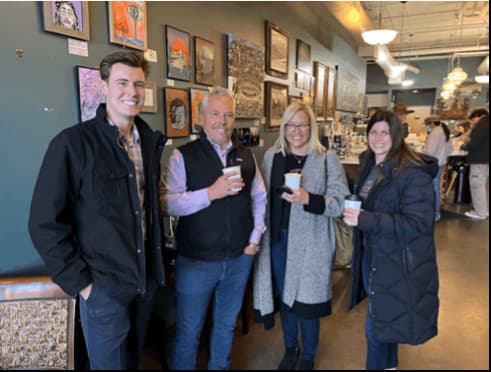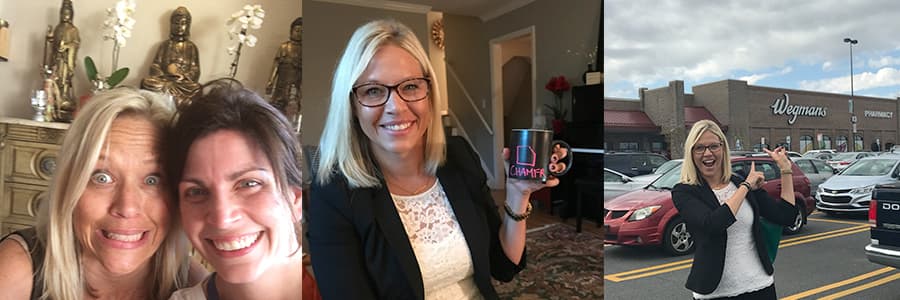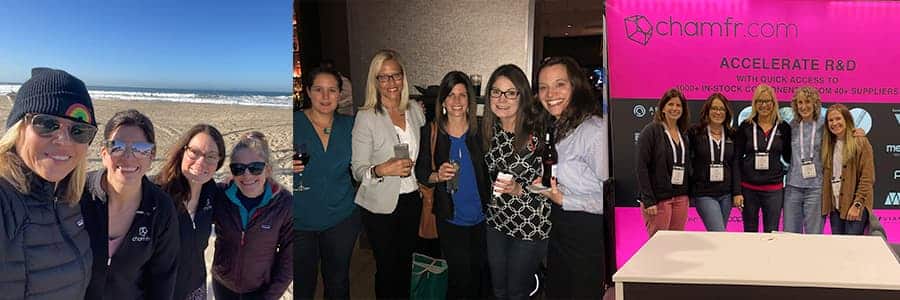My Medtech Life: Julie Schulte (Part II)
Part II of II
Welcome to our blog series sharing highlights from conversations with leaders of companies that are helping to shape and drive the medical device industry forward.

This month, we bring you part II of our conversation with Julie Schulte, Co-founder and CEO of Chamfr. Chamfr is an online marketplace that gives engineers quick access to thousands of in-stock medical components to accelerate R&D. Read part I of our conversation.
With nearly two decades in the medical device industry, Julie has held roles in sales and marketing as well as executive leadership. Before founding Chamfr in 2017, she was President of Meraqi Medical (now part of Viant).
In part II of a two-part interview, learn how the seed was planted for Chamfr, how the pandemic forced companies to go digital, and why one young company has cancelled all its marketing channels except Chamfr.
What gave you the idea for Chamfr?
When we were in the process of selling Vention, several companies approached me asking if I would work with them to build an ecommerce store like we did at Vention. I was passionate about digital and understood the huge investment it takes to build a successful ecommerce store. But I also knew that if I were the CEO of a medtech company, the smartest and most efficient use of my capital and resources would be focused on being the best at the technology and service offering, not figuring out how to become a marketing and ecommerce company.
So I had the idea to develop a single solution that every supplier could leverage for a fraction of the investment of cost and time. This one-stop shop would also better serve buyers by giving them one place to go for all of their component sourcing needs instead of having to navigate 50 different websites. When I explained the concept to one of my mentors, he said, “You mean like Amazon?” And I said, “Yes, exactly!”
Once the seed was planted, I couldn’t stop thinking about it. It solved an unmet need AND it streamlined operations and reduced costs for all.
A couple months later, one of my co-founders approached me with a similar idea. We started throwing ideas back and forth, meeting on lunch breaks and early mornings before our kids woke up. The next thing we knew we were brainstorming and writing a business plan.
When did Chamfr go from being an idea to becoming a real business?
At one point, I was like, “This is crazy! Am I really going to interrupt my career at its peak, dig into savings, and risk it all to do something totally novel in our space?” Right before we went to incorporate, I got cold feet. My co-founder said, “I’m doing this with or without you.” I said, “Oh, no you’re not!” So that pushed us to take the plunge and file our documents in September of 2017. Months later she admitted that she wouldn’t really have done it without me, but it was the FOMO (fear of missing out) that ultimately motivated me to make the commitment.
How did you assemble your “dream team” of co-founders Katie Karmelek and Kathryn Misra?
I would never have started this business if I didn’t already know that those two were going be part of it. The three of us had been working together for more than 10 years, which gave me both the vision for how we could launch this and the courage to actually do it. One of the reasons we’re such a great team is that we all have very different skill sets; we complement each other really well. We’re all hard working, we want to innovate, and we want to succeed.
And we’re dedicated. What often differentiates successful businesses from those that fail is that people give up. It gets hard. Life happens, personally and professionally. But every day—good days and bad—we’re all back at it, continuing to do the work. I’m very lucky to be working with this team.

What were some of the early challenges in getting Chamfr off the ground?
We created a business model that was totally new in the medical device space. Most start-up companies focus on a particular type of component, device, or service offering, and there’s a well-established process for funding and growing that type of company. But there was nothing like this in our industry, so it was sometimes hard for people to understand how it could work. Many suppliers weren’t ready to adopt or commit to a digital model. Our industry was very comfortable operating as it had been for decades and wasn’t too keen to disrupt the status quo.
But the buyers were ready, and that made all the difference. Buyers needed Chamfr because the old way of operating was too slow, too manual, and too cumbersome to be effective. Like most of us, they had established online buying behaviors and expectations from shopping at Amazon. Chamfr is often compared to Amazon because it’s a marketplace with many sellers, and everyone knows how that works as a consumer.
Did people “get it” right away? Did you have to figure out how to articulate your vision in a way that potential investors and/or customers would understand?
Some did, but most did not! We were trying to educate people and sell our solution at the same time. For us, the COVID-19 pandemic was a pivotal moment. Everyone was forced to start thinking about digital solutions in a new way, whether they were ready for it or not.
Because Chamfr is a new channel, we constantly have to demonstrate to potential sellers that the ROI is definitely there, then compare it with other marketing channels. For example, companies have traditionally been willing to pay tens of thousands of dollars to exhibit at a tradeshow (plus travel and entertainment costs), with no guarantee of quality leads and no income generated.
But at the same time, we hear company leaders say that they’re not sure about paying a fraction of that cost to get inbound, 100% qualified leads and a streamlined process that actually saves resources and generates revenue. Those inbound leads are coming in monthly, weekly, or even daily in some cases, when suppliers have really committed to inventorying product. A new seller recently said, “My only regret is that I didn’t do this sooner. It’s like the tradeshow that keeps on giving!”

Can you share some memorable moments from Chamfr’s early days?
I have so many stories! Here are just a few.
- Early on, we hired a developer to create an MVP (minimum viable product). The first red flag was that he looked nothing like his LinkedIn profile. When we would ask him about the various functionalities we needed, he would Google it. Plus, he brought his wife to our dinner (which was at Wegmans – an east coast grocery store), and they spent the whole time canoodling. We were in a panic after that meeting and spent the four-hour drive back to Boston calling everyone we knew to find a new developer.
- We bootstrapped the company and had very lean budgets. At a dinner with one of our first sellers, the CEO ended up inviting six or seven people from his team, and they kept ordering expensive drinks. The bill came to nearly $1,000 and I was about to suck it up and put it on my personal credit card when the sales rep who loved our business model and saw value in getting the leads swooped in and picked up the check. Whew! (Luckily they did end up coming on board.)
- In an attempt to save money on lodging at a tradeshow, we booked a $50 per night airbnb that had dirty hand towels and no bath towels. We texted the host and found out that “towels weren’t included.” Then we realized the sheets were dirty, too, and the host told us to find clean ones in the closet. We opened what we thought was the closet door and found a garage with multiple mattresses with bedding. We were totally freaked out and ended up leaving and finding a hotel. We learned that there’s a limit to how cheap you can go!

What needs did you see in the industry on the buyer side that Chamfr could address?
We wanted to create a system that worked for both buyers and suppliers: one that improved efficiencies, made economic sense, and resulted in a clear return on investment (ROI), which can be a rare thing in marketing.
Buyers needed:
- Quicker, easier access to low-volume components for prototyping: Our prior experience showed us that design engineers—buyers—had a hard time purchasing low-volume components for prototypes, and the lead times were often really long. Chamfr gives buyers quick access to in-stock, low-volume components, which allows them to iterate quicker in the early stages of product development and get to design freeze faster. Reducing lead times ultimately saves costs and speeds time to market.
- A convenient one-stop shop with one check-out process: With Chamfr, there’s one central place where design engineers can go to look for all the components they need. They don’t have to navigate 50 different online stores, all with different products, functionality, checkout processes, and lead times.
What needs did you see on the seller side that Chamfr could address?
Sellers needed:
- Early access to qualified customers: Sellers need to know who the decision makers are at their point of need so their components can get spec’d in. Chamfr provides inbound leads, direct access to decision-makers, and 100% qualified customers who are ready to source. They’re on Chamfr because they have an active project and a real need for both components and services.
- Streamlined operations: Sellers need a more streamlined process for both transacting with buyers at this early point of need and for fulfilling the request internally, which could be time consuming when you need a quote, a PO, and capacity on the manufacturing floor. Chamfr is a solution that streamlines operations and allows manufacturers to build when they have capacity vs on demand for the “onesie twosie” orders.
- Turnkey process so they can focus on their core business: Chamfr allows sellers to focus on what they do best—designing and manufacturing components—rather than making the huge investment needed to build and maintain their own online store. Chamfr provides a turnkey solution that manages all the functional upgrades as well as financial transacting, collections, hosting, security, and risks associated with maintaining a digital platform; at a fraction of the time and cost.
Can you share some of the success stories you’ve heard from customers?
On a regular basis, we have engineers reaching out to us saying, “Thank you for building this. It’s exactly what we’ve needed for so long. Can you add more components? Can you get more suppliers?” Here are a few of my favorite stories.
- At MD&M MN, an engineer came to our booth and said Chamfr is his first stop when sourcing components for a project. He had started several companies and built all his MVPs with components he sourced from our site. He said, “Tell me what I can do to help you get more suppliers committed.”
- A VP of R&D from a large customer contacted us just last week looking to find out about us and our model. He said, “I want every one of my buyers to know who you are and to be looking at your site. They’re struggling to find products and good sellers, and this is amazing—every one of them should be visiting your site.”
- A large supplier upended their business model to sell components on our site, and within a couple months they had several long-term supply contracts, including one for 100,000 units that they got just by following up on an inbound lead from an order placed on Chamfr.
- One of our sellers recently told us that they’re canceling every other marketing and advertising channel because Chamfr is hands-down the best ROI for any marketing initiative in the industry, when executed on thoughtfully.
One of the most rewarding things about our model is that it’s a win-win for buyers and sellers. It’s connecting both parties at their point of need more effectively and efficiently. We constantly get positive feedback from both sides. It’s fun to be part of that.
What are some of the overall economic trends affecting the medical device industry? What can Chamfr do to help address them?
In the past couple of years, supply chain disruption and staffing shortages have been major issues industry wide and have affected medical device innovation and supply globally. People can’t fulfill manufacturing orders due to material shortages and labor shortages. People are at capacity and are not able to add shifts or flex like we have in the past. It’s been really painful all around. And it’s having a huge impact on innovation and R&D, delaying product launches and clinical and commercial scale. The small and mid-tier companies that don’t have the leverage or the cash to throw at the problems are particularly affected.
I do think we’re starting to see some early signs of relief in the supply chain, though. Companies are approaching us about using Chamfr as a means to offload some of the products they’d been holding in strategic inventory. It’s really exciting that we’re able to provide an easy, effective solution for global distribution. One that has the ability to enable companies to return to normal faster by giving visibility and access to the excess materials to be effectively redistributed; that’s powerful.
What’s ahead for Chamfr?
More products and more sellers! Our goal is to be the first place every medical device engineer in the world goes to source components, equipment, and look for service providers when they’re developing a product. We want to more effectively connect buyers and suppliers digitally and globally so that they can more efficiently work together to source components and manage their supply chain needs.
At five years old, we’ve really just built the foundation. We have a long list of functional upgrades in our product roadmap, like digital tools and communication, automation, analytics, and forward-looking ways of working with suppliers to further support the engineers and OEMs—all with the goal of giving them tools they need for agile development so that together, we can accelerate innovations for health.


Let’s keep in touch.
Don’t miss seller news, product alerts, and insights. Sign up for our emails to receive updates directly in your inbox.